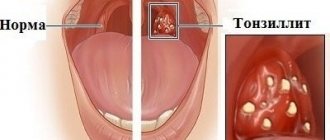In some cases, tonsils may become enlarged without fever. Enlarged tonsils without fever require the same attention and treatment approach to avoid the development of complications.
Author:
- Chuprikov Roman Sergeevich
ENT pathology expert
3.45 (Votes: 33)
Tonsils (tonsils) are an important organ of the human immune system, involved in protecting the body from harmful carriers and preventing their spread. Their main task is to identify pathogenic microorganisms and produce antibodies to fight them.
Enlarged tonsils themselves are not a disease, but a symptom. They can increase:
- with infection;
- with genetically determined hypertrophy;
- for blood diseases (lymphoproliferative diseases);
- for autoimmune diseases;
- for allergic inflammation and swelling.
Usually these processes are accompanied by an increase in temperature, but in some cases the tonsils can enlarge without an increase in temperature. This often forces one to delay a visit to the doctor, since temperature is considered a marker of the disease. But enlarged tonsils without fever require the same attention and treatment approach to avoid the development of complications.
Under what conditions can tonsils be enlarged without fever?
Without an increase in temperature, the tonsils can become inflamed due to:
- Allergies. Enlarged tonsils often occur in people prone to allergies. Allergens include various substances - animal hair, dust, pollen, food, insects, household chemicals.
- Fungal infection. The following symptoms are observed: sore throat, dry mouth, visible cheesy coating on the mucous membrane.
- Dry air. Due to constant inhalation of dry air, the mucous membrane of the larynx dries out, causing the tonsils to swell. Working in polluted conditions also leads to this.
- Smoking. Tobacco smoke burns the mucous membrane, which can result in swelling of the tonsils.
- Some forms of sore throat (tonsillitis). The biological meaning of an increase in temperature during infectious diseases is to accelerate the death of pathogenic carriers in an environment with high temperatures. Consequently, if the body temperature has not increased, it means that the number of infectious carriers that have entered the body is small. Usually, if the infection was minor, then the person easily and quickly suffers from this illness. But with enlarged tonsils and no temperature, we can talk about an untreated acute inflammatory process in the tissues of the tonsils and its transition to chronic. In this case, the recovery process will take longer, and in addition, there is a possibility of complications developing. Both variants of pathologies require examination and prescription of correct treatment by an otolaryngologist.
Complications and how to avoid them
One of the very rare complications: velopharyngeal insufficiency. After surgery, velum closure may be impaired. This complication is manifested by the appearance of a nasal voice in the patient, the appearance of snoring during sleep, and disturbances in the processes of speech and swallowing food. More often, this complication appears in patients with a hidden cleft of the hard palate that was not diagnosed before surgery. To exclude such a condition, a thorough examination of patients is necessary. One of the signs of the presence of a submucosal cleft of the hard palate is the splitting of the uvula.
Features of the condition with enlarged tonsils without fever
Even at normal body temperature, but in the presence of pathological processes in the body, a person may feel completely unwell. Inflammation of the tonsils without fever, regardless of the cause, can interfere with a normal lifestyle and be accompanied by:
- headache;
- sore throat;
- lack of appetite;
- difficulty swallowing;
- dryness and sore throat;
- enlarged lymph nodes and pain on palpation;
- fatigue, weakness, drowsiness, decreased performance, irritability.
Comparative characteristics of the two methods
Laser tonsil removal
Carbon dioxide laser is used (CO2 laser)
- the operation is almost bloodless
- lower risk of bleeding after surgery
- faster wound healing compared to traditional removal
- less pain in the postoperative period
- Minuses:
- heating of surrounding tissues, there may be burns to the edges of the wound.
Radio wave tonsil removal
Surgitron radiosurgical device is used
- the operation is also almost bloodless
- radio wave produces an antibacterial effect, reducing the likelihood of inflammation after surgery
- postoperative swelling in the wound is less pronounced, the wound heals much faster
- there are no burns or damage to healthy tissues, because the effect of the cut is carried out without physical pressure, the removal of the tonsil is carried out carefully
- early complete tissue healing without the formation of a rough scar
In some cases, to achieve maximum effectiveness, doctors can use a combined method: both laser and radio wave.
Treatment of enlarged tonsils without fever
Before prescribing treatment, it is necessary to establish the cause of inflammation of the tonsils.
If the cause is an infectious or fungal infection, then the patient is prescribed a course of antibacterial therapy, treatment of the throat and mucous membranes with special preparations, infusions into the larynx, rinsing the tonsils, and taking vitamin complexes to support the immune system.
If conservative treatment is ineffective, a tonsillectomy may be prescribed - surgical removal of the tonsils. Most often, this is an indication for the treatment of chronic tonsillitis, which occurs with toxic-allergic manifestations and seriously interferes with a person’s comfortable life.
If swelling of the tonsils is associated with external factors - smoking, working in unsuitable conditions, attacks by allergens, the doctor will advise correction of lifestyle or environmental conditions, and taking supportive medications.
Radio wave method for tonsil removal
The radio signal transmitted by the electrode causes the evaporation of intracellular fluid and, as a result, tissue dissection. High-frequency waves are absorbed by intracellular fluid, thereby reducing the risk of damage to adjacent organs and tissues.
In the photo, an operation to remove tonsils is performed by Dr. Andrey Borisovich Starosvetsky, otolaryngologist, rhinosurgeon, candidate of medical sciences.
The operation is performed using the radio wave method under local anesthesia.
Advantages of the radio wave tonsil removal method
- Minimal tissue damage during incision:
- the degree of thermal damage is 3 times less compared to traditional electrosurgical exposure and 2-3 times less than most lasers;
- minimal necrosis in the area of the surgical wound and adjacent tissues;
- Acceleration of tissue regeneration processes:
- reduction of tissue pain during radio wave dissection due to coagulation of nerve endings.
- low postoperative wound pain.
- Sterilizing effect:
- reducing the risk of postoperative complications.
- High cosmetic effect:
- early complete healing of tissues without the formation of a rough scar.
Prevention
To prevent pathological enlargement of the tonsils, you must adhere to the following recommendations:
- Increase immunity: eat properly and well, exercise, exercise, give up bad habits, and maintain proper sleep patterns.
- Avoid provoking factors: do not overcool, humidify the air in the room, remove allergens from the environment.
- Treat infectious diseases promptly at the very beginning and prevent them from becoming chronic.
- Carry out preventive gargling and rinsing of tonsil lacunae. These procedures are carried out in our clinic, and our doctors will be happy to advise you about them.
If you are concerned about enlarged tonsils without fever, make an appointment with otolaryngologists at the Ear, Nose and Throat Clinic - you will receive comprehensive consultations and quality treatment.
Anesthesia
Tonsillectomy surgery is performed under both local anesthesia and general anesthesia (anesthesia). Both methods of pain relief have pros and cons, so the decision is made by the attending doctor, taking into account the health condition and wishes of the patient.
Local anesthesia
The classic surgical technique (under local anesthesia) has been performed for many decades and still exists today. An anesthetic solution in an amount of about 20 ml is injected into several points around the tonsil - usually 1% lidocaine with the addition of adrenaline (to reduce bleeding). The effect is that the tissues are deeply impregnated with the drug, so the pain is almost not felt, and the tonsil appears to be raised above the palatine arches and is easy to isolate. This technique is called infiltration anesthesia.
If the patient has had allergic reactions to these drugs, they are replaced with ultracaine. Next, the operating doctor proceeds directly to removing the tonsils. The patient is only required to strictly follow his instructions. A tonsillectomy lasts about half an hour; before sending the patient into the room, the surgeon carefully checks whether the bleeding has stopped. This is an important point in the operation.
General anesthesia (anesthesia)
Nowadays, tonsillectomy is performed more and more often under general anesthesia. This is due to the fact that anesthetic equipment and drugs for anesthesia have changed a lot recently. Modern anesthetics are considered to be of a high safety class; they are non-toxic and do not carry the same complications as before. Anesthesia is easily tolerated by the patient and feels similar to normal sleep.
The photo shows an anesthesia device from the German company Drager used in the clinic.
To carry out general anesthesia, the patient is carefully examined; before the operation, he is examined by an anesthesiologist, since, despite the safety of anesthesia, if there are deviations in the tests, the operation can be postponed. The operation is performed strictly on an empty stomach; the patient cannot even drink water. After the examination, the patient is escorted to the operating room, where he is placed on the operating table and put on a breathing mask. A mixture of oxygen and anesthesia medication is supplied to it, sleep occurs within a few minutes, and the operation ends for the patient - awakening occurs in the ward.
Doctors anesthesiologists
The clinic employs highly qualified anesthesiologists, including specialists from the Children's Clinical Hospital named after. N.F. Filatov, who have academic degrees of candidates and doctors of medical sciences, many years of unique work experience. Our specialists use an anesthetic apparatus from the German company Drager and the latest generation of medicines. All this allows operations to be performed under general anesthesia (anesthesia), which is safe for the patient’s health, with further rapid recovery in the postoperative period.
Drugs
In their work, anesthesiologists use the drugs sevoran, diprivan, esmeron, enfluron, isoflurane, dormicum and others. The choice of a specific drug is at the discretion of the anesthesiologist and depends on each specific case, test results and other factors.
Tonsils - what are they and why are they needed?
The tonsils are represented by lymphoid tissue, which provides human protection, that is, it belongs to the organs of the immune system. The tonsils prevent harmful flora from entering the respiratory tract.
Lymphoid tissue contains lymphocytes. These cells actively fight microbes, viruses and fungi, preventing them from multiplying. The tissue of the tonsils is loose, so representatives of pathogenic flora are retained in it. If protection is provided at the proper level, then they will simply be destroyed by lymphocytes.
The tonsils (or palatine tonsils, which are located between the palatine arches) are a collection of lymphoid tissue that is designed to protect the respiratory system. The tubal tonsils are paired and are located in the pharynx. If you just look into your mouth, you won't be able to see them. They are rarely subject to inflammation.
Single tonsils include the pharyngeal and lingual tonsils. The pharyngeal tonsil is located at the arch of the pharyngeal wall. It is called adenoids, and when it becomes inflamed, it indicates adenoiditis. It most often affects young children. In adults it undergoes reverse development. The lingual tonsil is located under the tongue at the back of it. It gets inflamed less often than others.
Causes of enlarged tonsils in children
The increase is caused by the following infectious agents: pneumococci, staphylococci, herpes, streptococci, chlamydia, Haemophilus influenzae, adenovirus, influenza virus. They can be located in the lacunae of the tonsils without manifesting themselves in any way (for example, remain after treatment for a disease), but at a favorable moment they begin to actively multiply and cause an enlargement of the organ. Such triggers can be:
- decreased immunity;
- allergies;
- bad ecology;
- hormonal disorders;
- severe hypothermia;
- lack of vitamins;
- infections.
Why do you still need to remove your tonsils?
According to the results of many different studies, a large number of different pathogens have been identified, including streptococci, staphylococci, Haemophilus influenzae, lymphotropic viruses, etc., which contribute to the development of chronic tonsillitis.
But the leading role in the development of chronic changes in the palatine tonsils, as well as local and general complications of chronic tonsillitis, is played by beta-hemolytic streptococcus from group A (S. pyogenes) - a microorganism that also uses anaerobic respiration for its vital functions. This bacterium is more often found in the deep sections of the recesses (crypts) of the palatine tonsils, since they contain the least amount of oxygen, which is the most favorable environment for the proliferation of anaerobic microorganisms.
Chronic tonsillitis becomes a focus of infection, a chronic infectious-allergic disease with a local inflammatory reaction in the palatine tonsils - all this is a consequence of the activity of not only beta-hemolytic streptococcus, but also its antigens and various pathogenicity factors, namely streptolysins.3
As a source of infection, chronic tonsillitis causes intoxication of the body. A separate problem is caused by various complications of chronic tonsillitis, for example paratonsillitis and paratonsillar abscess are quite common.
The treatment of such complications may require not only outpatient care, but also inpatient treatment with surgical intervention.
Common complications of chronic tonsillitis are: tonsillogenic sepsis (life-threatening condition), rheumatoid arthritis, endocarditis, glomerulonephritis. These conditions significantly reduce the quality of life of patients and can lead to disability.4
In connection with the above, the main treatment tactic is sanitization of the source of infection, in other words, elimination of the pathogen. There are two treatment methods - conservative or surgical.
The choice of method is currently clearly regulated and based on the classification of B.S. Preobrazhensky and V.T. Palchuna.5
This classification is based on the symptoms of chronic tonsillitis, as well as the presence and severity of toxic-allergic reactions and the presence of complications. The classification identifies 2 forms of chronic tonsillitis:
- simple (characterized by the presence of only local signs of chronic tonsillitis and tonsillitis no more than 1–2 times a year)
- toxic-allergic: toxic-allergic form I and toxic-allergic form II6
Tonsil hypertrophy
Palatine tonsil hypertrophy is a persistent enlargement of the tonsils that interferes with breathing through the mouth. With hypertrophy, breathing during sleep occurs with episodes of stopping, and snoring intensifies. There may be difficulty swallowing food, and speech becomes difficult.
To determine the degree of enlargement of the tonsils, the pharynx is examined. The doctor focuses on the edge of the anterior arch and the midline of the pharynx (uvula-uvula). The distance is divided into three conventional parts .
There is a classification in which several stages of tonsil hypertrophy are distinguished:
- I degree of hypertrophy - an increase in the tonsil by 1/3 of the distance from the arch to the uvula (the tonsils look behind the arches in the larynx)
- II degree of hypertrophy - tonsils are enlarged by 2/3 of the space from the arch to the uvula
- III degree of hypertrophy - the tonsils are greatly enlarged, reach the uvula and can even touch it
Complications of tonsillectomy
The most serious complication during and after removal of the tonsils is bleeding from the site of the surgical intervention - the tonsil niche. Bleeding can be vascular, parenchymal, arterial, venous, and the cause may also be invisible.
Bleeding in the postoperative period was observed in 1.5-13% of patients. A favorable outcome of the operation depends on knowledge of the location of the large tonsillar vessels of the palatine tonsils and the use of modern, less traumatic surgical methods.12
It is worth noting what may bother the patient after surgery:
- Small blood clots
- Pain and discomfort at rest and swallowing
- Scar changes on the palate
Tonsillectomy is a serious surgical intervention that requires an integrated approach, starting from indications for surgery, preparation, and ending with strict adherence to all recommendations. Precise execution of each step can contribute to a favorable outcome of the operation and minimize the risks of complications.











